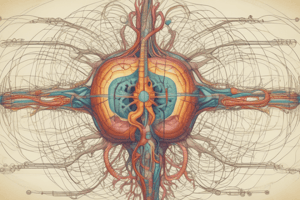Podcast
Questions and Answers
Explain how neurotransmission mechanisms function in the peripheral autonomic system.
Explain how neurotransmission mechanisms function in the peripheral autonomic system.
Neurotransmission in the peripheral autonomic system involves the release of neurotransmitters that bind to receptors on target organs to elicit physiological responses.
What role does the sympathetic nervous system play in regulating blood pressure?
What role does the sympathetic nervous system play in regulating blood pressure?
The sympathetic nervous system mediates responses critical for maintaining blood pressure.
Describe the effects of the parasympathetic nervous system on heart rate.
Describe the effects of the parasympathetic nervous system on heart rate.
The parasympathetic nervous system predominantly slows down the heart rate.
How does the parasympathetic system affect the bronchi compared to the sympathetic system?
How does the parasympathetic system affect the bronchi compared to the sympathetic system?
What is the primary effect of the sympathetic nervous system on the heart?
What is the primary effect of the sympathetic nervous system on the heart?
What mechanisms are involved in the autonomic regulation of thermoregulation?
What mechanisms are involved in the autonomic regulation of thermoregulation?
Describe the role of the sympathetic nervous system in regulating blood pressure through vascular actions.
Describe the role of the sympathetic nervous system in regulating blood pressure through vascular actions.
Identify a critical area in the brainstem that controls autonomic function.
Identify a critical area in the brainstem that controls autonomic function.
How does the autonomic nervous system respond to stress?
How does the autonomic nervous system respond to stress?
What is the effect of the sympathetic system on salivary glands, and how does this contrast with the parasympathetic system?
What is the effect of the sympathetic system on salivary glands, and how does this contrast with the parasympathetic system?
Explain how the ciliary muscle is affected by the parasympathetic nervous system.
Explain how the ciliary muscle is affected by the parasympathetic nervous system.
What factors influence the local regulation of blood flow by the autonomic system?
What factors influence the local regulation of blood flow by the autonomic system?
What is autonomic dysreflexia and its relationship to autonomic function?
What is autonomic dysreflexia and its relationship to autonomic function?
What are the three critical functions that peripheral sympathetic outputs maintain?
What are the three critical functions that peripheral sympathetic outputs maintain?
Which autonomic reflexes are controlled by the parasympathetic system?
Which autonomic reflexes are controlled by the parasympathetic system?
Identify the brain regions associated with generating autonomic responses to stimuli.
Identify the brain regions associated with generating autonomic responses to stimuli.
How do hypothalamic nuclei contribute to autonomic function?
How do hypothalamic nuclei contribute to autonomic function?
What are some disorders that can affect autonomic pathways?
What are some disorders that can affect autonomic pathways?
What are some symptoms related to autonomic hyperactivity?
What are some symptoms related to autonomic hyperactivity?
What is the relationship between brainstem nuclei and autonomic function?
What is the relationship between brainstem nuclei and autonomic function?
What roles do neurotransmission mechanisms play in autonomic functioning?
What roles do neurotransmission mechanisms play in autonomic functioning?
Flashcards are hidden until you start studying
Study Notes
Introduction to Autonomic Nervous System
- Understanding of autonomic nervous system (ANS) anatomy, physiology, and pathophysiology is crucial for evaluating and managing neurologic disorders.
- Peripheral autonomic system's anatomy and neurotransmission are foundational for understanding autonomic function.
Autonomic Functions and Regulation
- Sympathetic nervous system (SNS) is essential for maintaining blood pressure, regulating blood flow, thermoregulation, and responses to stress and exercise.
- Parasympathetic nervous system (PNS) controls functions such as:
- Lacrimation and salivation
- Pupil response to light
- Heart rate regulation
- Gastrointestinal motility
- Micturition and erectile function
Brain Regions Involved
- Insular cortex, anterior and midcingulate cortex, and amygdala generate autonomic responses based on behaviorally relevant stimuli.
- Hypothalamus coordinates autonomic responses to internal and social stressors.
- Brainstem nuclei are involved in integrated autonomic function related to respiration and sleep-wake cycles.
Disorders of the Autonomic System
- Central and peripheral autonomic pathways may suffer dysfunction, leading to symptomatic conditions:
- Autonomic failure can cause orthostatic hypotension, anhidrosis, gastrointestinal dysmotility, and neurogenic bladder or erectile dysfunction.
- Autonomic hyperactivity is associated with primary hypertension, tachycardia, and hyperhidrosis.
Sympathetic vs. Parasympathetic Effects
-
Pupil Response:
- Sympathetic: Dilation (α1 receptors)
- Parasympathetic: Constriction (M3 receptors)
-
Ciliary Muscle:
- Sympathetic: No effect
- Parasympathetic: Accommodation (M3 receptors)
-
Salivary and Lacrimal Glands:
- Sympathetic: Inhibition (α2?)
- Parasympathetic: Stimulation (M3, vasoactive intestinal polypeptide receptors)
-
Heart:
- Sympathetic: Stimulation (β1 receptors)
- Parasympathetic: Inhibition (M2 receptors)
-
Bronchi:
- Sympathetic: Dilation (β2 receptors)
- Parasympathetic: Constriction (M3 receptors)
-
Skeletal Muscle Vessels:
- Sympathetic: Dilation (β2), Constriction (α1)
- Parasympathetic: No effect
-
Skin Vessels:
- Sympathetic: Constriction (α1), possible dilation
- Parasympathetic: No effect
Studying That Suits You
Use AI to generate personalized quizzes and flashcards to suit your learning preferences.




